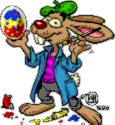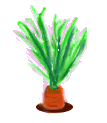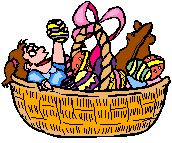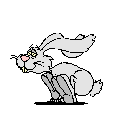Easter
IsA TimeOf
Springtime Festivals
|
{A Small Bit Of Easter History}
Of all the symbols associated with
Easter, the egg
|
|
represent the sunlight of spring and were used in Easter-egg rolling contests or given as gifts. After they were colored and etched with various designs, the eggs were exchanged by lovers and romantic admirers, much the same as valentines. In medieval times, eggs were traditionally given at Easter to the servants. In Germany eggs were given to children along with other Easter gifts. |
 |
|
decorating Easter eggs. Crimson eggs, to honor the blood of Christ, are exchanged in Greece. In parts of Germany and Austria, green eggs are used on Maundy Thursday (Holy Thursday). Slavic peoples decorate their eggs in special patterns of gold and silver.
Austrian artists design patterns by fastening ferns and
|
 |
|
Melted beeswax is applied to the fresh white egg. It is then dipped in successive baths of dye. After each dip, wax is painted over the area where the preceding color is to remain. Eventually a complex pattern of lines and colors emerges into a work of art.
In Germany and other countries, eggs used for cooking
|
 |
|
For those of you that may not remember all the different ways, here are some ideas. {Anything goes when decorating hard cooked eggs.} Pictured eggs are decorated in these manners; 1. Colored felt tip pens: (lightning bolts, mosaics, thunder clouds, flower designs).
2.
Melted Crayons: Hold crayon in candle flame* and let melted crayon
drip
3. Stamps: A star stamp on a gold stamp pad makes an elegant egg design. 4. Spray paint: Our silver eggs were placed on old newspaper and sprayed**. 5. Commercial Dyes: These are simple to do and make an eggscellent base *Recommend parental supervision.
Other ideas: Thumbprint Eggs: Roll thumb
on stamp pad then onto hard cooked eggs.
Personalized Eggs: Use decals to put kids names on hard cooked eggs. Pastel Eggs: Use commercial dyes but leave eggs in color for 1 hour only. Stamped Eggs: Use favorite stamps to decorate hard cooked eggs. |
 |
 |
 |
 |

HOP them over to me.
|
|
Easter Parade |
|